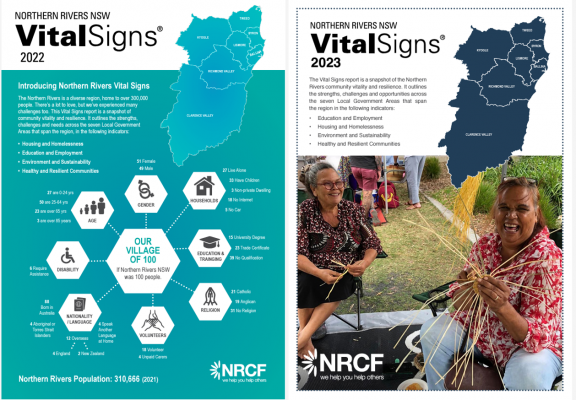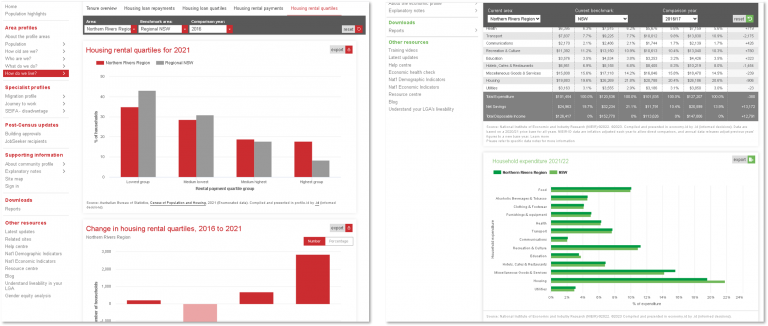While .id is primarily known for working with local government authorities or private businesses and organisations who use our forecast data to plan for the future, we also work with community organisations working towards or supporting the wellbeing of local residents and those in need by investing locally based on informed decisions.
One such organisation we’ve had the pleasure of working with has been the Northern Rivers Community Foundation (NRCF). This blog describes and summarises our relationship, what we produced for NRCF and how they used the information provided by .id to empower their decision-making and focus in the Northern Rivers region of New South Wales during and following catastrophic floods.
Who are the NRCF?
The NRCF is a charity dedicated to improving the lives of those less fortunate in the community. They are a community-based independent foundation where donations are invested to build a capital amount of money. They invest this wisely in ethical funds, and their interest and dividends go towards our annual grant program.
The community foundation grants touch on people’s right to health, employment, higher education, happiness and creative expression, and the challenges of living in a regional community.
Broadly, the NRCF operates across four areas: Disadvantage, Disaster response, Environment and Housing issues.
Q&A with NRCF
I spoke with Kyla White, the Community Impact Manager at NRCF, who generously provided insight into how their organisation works, their experience of working with .id since 2022 and how the results of our collaborative work benefit their community.
How does the NRCF use demographic information?
“The NRCF use demographic and socioeconomic information to inform the Vital Signs report, to build community capacity, connect people and causes and guide grant making.” Kyla also told us objective demographic information provides an essential touchstone for community leaders, service organisations and funders to identify local priorities and opportunities and decide where to focus attention and resources for the most significant impact.
We collaborated on NRCF’s first-ever “Vital Signs” report. Why did NRCF need a “Vital Signs” report?
“For almost 20 years, NRCF has been responding to the changing needs of our community. During that time, not only has our community changed, but the Foundation has grown in its reach and impact.” Kyla explained, “The key driver for us to produce the first report was to deliver impact through evidence-based, locally relevant solutions to improve the quality of life at the community level. The report was critical in providing a deeper understanding of the need.”
.
The Vital Signs report had been gaining traction as a national program, and NRCF identified this as an opportunity to better understand their communities. Kyla also mentioned that the NRCF were “fortunate to receive funding support from a partner to deliver this project.”
How have the 2022 and 2023 publications of the Vital Signs reports been used by the NRCF?
"The NRCF Vital Signs reports measure the vitality of communities in key areas, providing critical information that can help set priorities and identify opportunities for action. “It helps our communities to make clear connections between issues and trends in different areas and highlights the strengths and challenges in our community, galvanising public interest and informing conversations around and responses to pressing social issues,” Kyla explained.
The 2022 Vital Signs report, and the 2023 Vital Signs report

NRCF uses the data to tell stories of our region. We can leverage the report’s data and narratives in conversations with funding bodies. The report also highlights further research opportunities.” said Kyla. Sharing the report strengthens stakeholder relationships, including research partners, funders, and supporters.
The report is also a “call to action”, encouraging readers to engage with it, delve deeper into community issues, and consider supporting causes they care about.
How did .id and the NRCF collaborate on the Vital Signs report?
.id assisted NRCF by collecting, validating and presenting information about the Northern Rivers communities, which addressed the different domains of the population, environment and economy. .id’s role was to provide appropriate, trustworthy information for the 2022 and 2023 editions of Vital Signs.
.id’s expertise in understanding data and knowing which information will correctly answer a question was highly important in this project. .id relied on traditional Census data and a wide range of national-level, government and public-sector published data.
Along with co-creating the Vital Signs reports, .id also built Community Profile and Economic Profile tools for the NRCF and encouraged them to share this resource in the region with other organisations who would benefit from them. .id’s client managers and demographic consultants actively informed any entities they know in the region about these resources during the post-flood cleanup.

Examples of information available in the Northern Rivers Community and Economic profile tools (https://id.com.au/northern-rivers)
What was your experience working with .id on the 2022 iteration of the Vital Signs report?
“Our consultant from .id exhibited a genuine interest in understanding our region, sharing valuable information, and emerged as a trusted and valuable partner throughout the process. Nenad’s commitment contributed significantly to the success of both the 2022 and 2023 Vital Signs reports,” said Kyla.
She added, “NRCF highly values .id’s support in providing accurate and insightful data.” and that “Nenad’s sensitivity to the disaster and challenges we were facing, and the commitment to supporting the production of the reports was uplifting”.
What was the key aim for the 2023 edition of the Vital Signs report? To quantify the disaster and recovery that occurred in the region?
“The initial 2022 report provided an interesting snapshot of our community at that time – a region still recovering from the 2019/2020 bushfires and Covid-19 pandemic, hit by two megafloods that devastated the region in February and March 2022, leaving thousands of people displaced and traumatised; 2022 was also an election year; and much of the data available to inform the report dated back to the 2016 Census.”
Kyla elaborates: “The 2023 report provided an opportunity to revise the report with the newly released 2021 Census data and provide a new post-flood report, benchmarking a region in the early stages of recovery from the Covid-19 pandemic and flooding disaster, as the housing crisis turned into a catastrophe with thousands still living in temporary shelters.”
The region needed critical recovery funding, and NRCF hoped that the report might provide evidence of the need for community organisations to apply for funding to support the region’s recovery.
Do you have any other comments about your experience working with .id on the 2022 and 2023 Vital Signs reports?
“The NRCF views .id as a trusted partner with a genuine interest in the region’s well-being. The collaboration has been invaluable, and NRCF looks forward to exploring future data-driven insights that empower the community.”
Can we help you?
As demonstrated in this case study, we have the confidence and experience of working with community organisations, researching and advising on the most appropriate information to use when setting strategic directions based on informed decisions.
If you’d like to discuss your project needs, please contact us.











